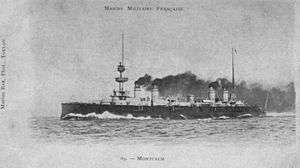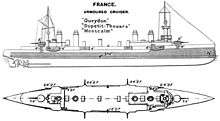Gueydon-class cruiser
 Portrait of Montcalm | |
| Class overview | |
|---|---|
| Name: | Gueydon |
| Operators: |
|
| Preceded by: | Jeanne d'Arc |
| Succeeded by: | Dupleix class |
| In commission: | 1902–35 |
| Completed: | 3 |
| Lost: | 1 |
| Scrapped: | 2 |
| General characteristics | |
| Type: | Armored cruiser |
| Displacement: | 9,516 tonnes |
| Length: | 139.90 m (459.0 ft) |
| Propulsion: | 3 engines and 3 propellers, 21500 HP |
| Speed: | 21.4 knots (39.6 km/h; 24.6 mph) |
| Armament: |
|
The Gueydon-class cruiser was a three-ship class of armored cruisers built in the first decade of the twentieth century for the French Navy.
Design and description

Designed by the naval architect Emile Bertin, the Gueydon-class ships were intended to be smaller and cheaper than the preceding armored cruiser design, the Jeanne d'Arc.[1] Like the older ship, they were intended to fill the commerce-raiding strategy of the Jeune École. The ships measured 137.97 meters (452 ft 8 in) long overall with a beam of 19.38 meters (63 ft 7 in) and had a maximum draft of 7.67 meters (25 ft 2 in). They displaced 9,367 metric tons (9,219 long tons). They had a crew of 566 officers and enlisted men.[2]
The Gueydon class had three vertical triple-expansion steam engines, each driving a single propeller shaft. Steam for the engines was provided by 20 or 28 boilers and they were rated at a total of 19,600–22,000 indicated horsepower (14,600–16,400 kW) that gave them a speed of 21–22 knots (39–41 km/h; 24–25 mph). The ships carried up to 1,575 metric tons (1,550 long tons; 1,736 short tons) of coal and could steam for 8,500 nautical miles (15,700 km; 9,800 mi) at a speed of 10 knots (19 km/h; 12 mph).[1]
The ships of the Gueydon class had a main armament that consisted of two 40-caliber Canon de 194 mm Modèle 1893-96 guns that were mounted in single gun turrets, one each fore and aft of the superstructure. Their secondary armament comprised eight 45-caliber quick-firing (QF) Canon de 164 mm Modèle 1893-96 guns in casemates. For anti-torpedo boat defense, they carried four 45-caliber QF 100-millimeter (3.9 in) guns on the forecastle deck, ten QF 47-millimeter (1.9 in) and four QF 37-millimeter (1.5 in) Hotchkiss guns. They were also armed with two submerged 450-millimeter (17.7 in) torpedo tubes.[1][2]
The Harvey armor belt of the Gueydon-class cruisers extended from 1.3 meters (4 ft 5 in) below the waterline to the main deck. It reached the upper deck for a length of 43.0 meters (141 ft) from the bow and covered the entire length of the ship except for 4.0 meters (13 ft) of the stern where it ended in a transverse bulkhead 84–41 millimeters (3.3–1.6 in) thick. The lower strake of armor was generally 150 millimeters (5.9 in) thick, although it reduced to 91 millimeters (3.6 in) forward, 81 millimeters (3.2 in) aft, and thinned to 51 millimeters (2 in) at its lower edge. The upper strake of armor had thicknesses of 97–81 millimeters (3.8–3.2 in) and 56–41 millimeters (2.2–1.6 in) between the main and upper decks.[1][2]
The curved lower protective deck ranged in thickness from 2 to 2.2 inches. In addition there was a light armor deck 20 millimeters (0.8 in) thick at the top of the lower armor strake. A watertight internal cofferdam, filled with cellulose, stretched between these two decks. The gun turrets were protected by 160–176-millimeter (6.3–6.9 in) armor and had roofs 23 millimeters (0.9 in) thick. Their ammunition hoists had 2 inches of armor and the 100-millimeter guns were protected by gun shields. The sides of the conning tower were 160 millimeters thick. The forward end of the casemate compartment was closed off by a 120-millimeter (4.7 in) bulkhead and a 102-millimeter (4 in) bulkhead extended down to the lower deck at the rear end of the compartment.[1][2]
Ships
- Dupetit-Thouars was torpedoed and sunk in 1918.
- Gueydon was decommissioned in 1935 and used as accommodation at Brest, was bombed and sunk in 1944, with the wreck broken up in 1945/46.
- Montcalm was decommissioned in 1926 and used as accommodation at Brest, renamed Tremintin in 1934, was bombed and sunk in 1944, with the wreck broken up in 1946/47.
References
Bibliography
- Chesneau, Roger & Kolesnik, Eugene M., eds. (1979). Conway's All the World's Fighting Ships 1860–1905. Greenwich: Conway Maritime Press. ISBN 0-8317-0302-4.
- Silverstone, Paul H. (1984). Directory of the World's Capital Ships. New York: Hippocrene Books. ISBN 0-88254-979-0.
- Sondhaus, Lawrence (2014). The Great War at Sea: A Naval History of the First World War. Cambridge: Cambridge University Press. ISBN 978-1-107-03690-1.
External links
![]() Media related to Gueydon class armoured cruisers at Wikimedia Commons
Media related to Gueydon class armoured cruisers at Wikimedia Commons